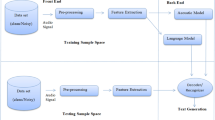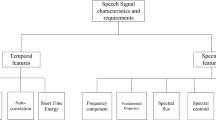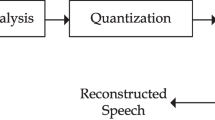Abstract
Compressed sensing, a new area of signal processing rising in recent years, seeks to minimize the number of samples that is necessary to be taken from a signal for precise reconstruction. The precondition of compressed sensing theory is the sparsity of signals. In this paper, two methods to estimate the sparsity level of the signal are formulated. And then an approach to estimate the sparsity level directly from the noisy signal is presented. Moreover, a scheme based on distributed compressed sensing for speech signal denoising is described in this work which exploits multiple measurements of the noisy speech signal to construct the block-sparse data and then reconstruct the original speech signal using block-sparse model-based Compressive Sampling Matching Pursuit (CoSaMP) algorithm. Several simulation results demonstrate the accuracy of the estimated sparsity level and that this denoising system for noisy speech signals can achieve favorable performance especially when speech signals suffer severe noise.
Similar content being viewed by others
References
D. L. Donoho. Compressed sensing. IEEE Transactions on Information Theory, 52(2006)4, 1289–1306.
R. G. Baraniuk. Compressed sensing. IEEE Signal Processing Magazine, 24(2007)4, 118–121.
Amir M. Abdulghani and Eather. Rodriguez-villegas. Compressive sensing: from “compressive while sensing” to “compressive and securing while sampling”. 2010 Annual International Conference of the IEEE Engineering in Medicine and Biology Society, Buenos Aires, Argentina, 2010, 1127–1130.
Jianwei Ma. Compressed sensing by iterative thresholding of geometric wavelets: A comparing study. International Journal of Wavelets, Multiresolution and Information Processing, 9(2011)1, 63–77.
Zhaorui Liu, H. Vicky Zhao, and A. Y. Elezzabi. Block-based adaptive compressed sensing for vedio, 17th International Conference on Image Processing, Hong Kong, 2010, 1649–1652.
S. Boll. Suppression of acoustic noise in speech using spectral subtraction. IEEE Transactions on Acoustic, Speech and Signal Processing, 27(1979)2, 113–120.
C. Plapous, C. Marro, P. Scalart, and L. Mauuary. A two-step noise reduction technique. IEEE International Conference on Acoustics, Specch and Signal Processing-proceedings, Montreal, Que, Canada, 2004, 1289–1292.
C. Plapous, C. Marro, and P. Scalart. Speech enhancement using harmonic regeneration. IEEE International Conference on Acoustics, Specch and Signal Processing-proceedings, Philadelphia, PA, United States, 2005, 1157–1160.
R. G. Baraniuk, V. Cevher, M. F. Durate, and C. Hegde. Model-based compressive sensing. IEEE Transactions on Information Theory, 56(2010)4, 1982–2001, 2010.
M. F. Duarate, S. Sarvotham, D. Baron, M. B. Wakin and R. G. Baraniuk. Distributed compressed sensing of jointly sparse signals. Conference Record of the Thirty-Ninth Asilomar Conference on Signals, Systems and Computers, Pacific Grove, CA, United States, 2005, 1537–1541.
S. S. Chen, D. L. Donoho, and M. A. Saunders. Atomic decomposition by basis pursuit. SIAM Journal of Scientific Computing, 20(1998)1, 33–61.
E. J. Candes, J. K. Romberg, and T. Tao. Robust uncertainty principles: exact signal reconstruction from highly incomplete frequency information. IEEE Transactions on Information Theory, 52(2006)2, 489–509.
S. G. Mallat and Z. Zhang. Matching pursuit and time-frequency dictionaries. IEEE Transactions on Signal Processing, 41(1993)12, 3397–3415.
D. L. Donoho, Y. Tsaig, I. Drori, and J. L. Starck. Sparse solution of underdetermined linear equations by stagewise orthogonal matching pursuit. http://www-stat.stanford.edu/~donoho/Reports/2006/StOMP-20060403.pdf, 2006
D. M. Malioutov, S. R. Senghavi, and A. S. Willsky. Compressed sensing with sequential observations. IEEE Journal of Selected Topics in Signal Processing, 4(2010)2, 435–444.
D. L. Donoho. Nonlinear wavelet methods for recovery of signals, densities, and spectra from indirect and noisy data. Different Perspectives on Wavelets, Proceedings of Symposia in Applied Mathematics, San Antonio, TX, United States, 1993, 173–205.
M. K. Hasan, M. S. A. Zilany, and M. R. Khan. DCT speech enhancement with hard and soft thresholding criteria. Electronics Letters, 38(2002)13, 669–670.
E. J. Candès and J. Romberg. Practical signal recovery from random projections. International Symposium on Electronic Imaging: Computational Imaging III, San Jose, CA, United States, 2005, 76–86.
H. S. Chang, Y. Weiss, and W. T. Freeman. Informative sensing of natural images. 16th IEEE International Conference on Image Processing, Cairo, Egypt, 2009, 3025–3028.
J. Y. Park, H. L. Yap, C. J. Rozell, and M. B. Wakin. Concentration of measure for block diagonal matrices with application to compressive sensing. IEEE Transactions on Signal Processing, 2011, preprint.
Y. C. Eldar and H. Bolcskei. Block-sparsity: coherence and efficient recovery. IEEE International Conference on Acoustic, speech and signal processing, Taipei, 2009, 2885–2888.
D. Needle and J. A. Tropp. CoSaMP: iterative signal recovery from incomplete and inaccurate samples. Applied and Computational Harmonic Analysis, 26(2009)3, 301–321.
C. Plapous, C. Marro, and P. Scalart. Improved signal-to-noise ratio estimation for speech enhancement. IEEE Transactions on Audio, Speech and Language Processing, 14(2006)6, 2098–2108.
Author information
Authors and Affiliations
Corresponding author
Additional information
Supported by the National Natural Science Foundation of China (No. 60971129); the National Research Program of China (973 Program) (No. 2011CB302303); the Scientific Innovation Research Program of College Graduate in Jiangsu Province (No. CXLX11_0408).
Communication author: Ji Yunyun, born in 1988, female, Ph.D. candidate.
About this article
Cite this article
Ji, Y., Yang, Z. A distributed compressed sensing approach for speech signal denoising. J. Electron.(China) 28, 509–517 (2011). https://doi.org/10.1007/s11767-012-0717-y
Received:
Revised:
Published:
Issue Date:
DOI: https://doi.org/10.1007/s11767-012-0717-y




